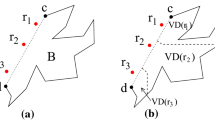Summary
The path existence problem and the collision detection problem for time-varying objects in a geometric scene are discussed. For a large class of spherical nonrigid objects, exact solutions of the path existence problem are developed based on decomposition techniques and graph traversal. For the collision detection problem of a single moving circle in the plane, efficient data structures are presented for linear/circular and polynomial paths.
Zusammenfassung
Gegenstand der Arbeit ist das Wegexistenzproblem und das Kollisionserkennungsproblem für zeitveränderliche Objekte in einer geometrischen Szene. Für eine große Klasse kugelförmiger nichtstarrer Objekte werden exakte Lösungen des Wegexistenzproblems entwickelt, die Zerlegungstechniken und Graphendurchlaufungen einsetzten. Ferner werden effiziente Datenstrukturen für das Kollisionserkennungsproblem eines Kreises in der Ebene vorgestellt, der sich auf linear/zirkulären oder polynomiellen Wegen in einer Szene fester Kreise bewegt.
Similar content being viewed by others
References
Badler NI, Smoliar SW (1979) Digital representation of human movement. ACM Computing Surveys 11:19–38
Bentley JL, Ottmann T (1979) Algorithms for reporting and counting geometric intersections. IEEE Transactions on Computers 28:643–647
Blume C, Jakob W (1983) Programming languages for industrial manipulators (in German). Vogel-Verlag, Würzburg
Böhm W, Farin G, Kahmann J (1985) A survey on curve and surface methods in CAGD. CAGD 1:1–60
Brooks RA (1983) Solving the find-path problem by good representation of free space. IEEE Transactions on Systems, Man and Cybernetics, pp 190–197
Brooks RA, Lozano-Perez T (1983) A subdivision algorithm in configuration space for findpath with rotation. IJCAI 00:799–806
Chazelle B (1985) Fast searching in a real algebraic manifold with applications to geometric complexity. CAAP '85:145–156
Edelsbrunner H (1987) Algorithms in combinatorial geometry. Springer-Verlag, Berlin
Fortune S (1986) A sweepline algorithm for Voronoi diagrams. 2. ACM Symposium on Computational Geometry, pp 313–322
Haussler D, Welzl E (1986) Epsilon-nets and simplex range queries. Discrete Computational Geometry 2:127–151
Hopcroft J, Joseph D, Whitesides S (1984) Movement problems for 2-dimensional linkage. SIAM Journal on Computing 13:610–629
Hopcroft J, Joseph D, Whitesides S (1985) On the movement of robot arms in 2-dimensional bounded regions. SIAM Journal on Computing 14:315–333
Kedem K, Sharir M (1985) An efficient algorithm for planning collisionfree translational motion of a convex polygonal object in 2-dimensional scene amidst polygonal obstacles. 1. ACM Symposium on Computational Geometry, pp 75–80
Lozano-Perez T, Wesley MA (1979) An algorithm for planning collision-free paths among polyhedral obstacles. CACM 22:560–570
Magnenat-Thalmann N, Thalmann D (1985) Computer animation: theory and practice. Springer-Verlag, Berlin
Mehlhorn K (1984) Data structures and algorithms III. Springer-Verlag, Berlin
O'Dunlaing C, Sharir M, Yap CK (1983) Retraction: a new approach to motion-planning. ACM Symposium on the Theory of Computing, pp 207–220
Preparata F, Shamos MI (1985) Computational geometry: an introduction. Springer-Verlag, New York
Reif JH (1979) Complexity of the mover's problem and generalizations. IEEE FOCS, pp 421–427
Sarnak N, Tarjan RH (1986) Planar point location using persistent search trees. Communications ACM 29:669–678
Schwartz JT, Sharir M (1983) On the piano movers problem. II. General techniques for computing topological properties of real algebraic manifolds. Advances in Applied Mathematics 4:298–351
Sharir M, Shorr A (1984) On shortest paths in polyhedral spaces. ACM STOC, pp 144–153
Wu YF, Widmayer P, Schlag MDF, Wong CK (1985) Rectilinear shortest paths and minimum spanning trees in the presence of rectilinear obstacles. IBM Research Report RC 11039(#49019)1/4/85
Yao AC, Yao FF (1985) A general approach to d-dimensional geometric queries. ACM STOC, pp 163–168
Author information
Authors and Affiliations
Additional information
Work was partially supported by DFG (Mu744/1-1).
Rights and permissions
About this article
Cite this article
Abramowski, S., Müller, H. Collision avoidance for nonrigid objects. Zeitschrift für Operations Research 32, 165–186 (1988). https://doi.org/10.1007/BF01928919
Published:
Issue Date:
DOI: https://doi.org/10.1007/BF01928919




